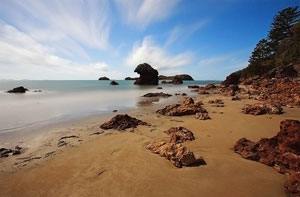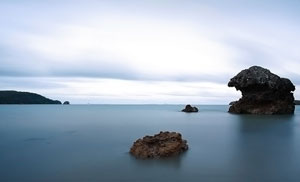How to photograph nightscapes with long exposure, so they look like daytime shots
While on a trip to the beach recently, I played around with long exposures at night time and realised it was possible to photograph nightscapes so they look as though they are taken during the day. Take the nightscape image shown below for example. As you can see, landscapes that would normally be photographed during the day, can look quite dreamy when taken at night with a long exposure.

This nightscape shown above was taken at Cape Hillsborough National Park (Australia), in total darkness at 8.14pm. It looks as though it was taken during the daytime because the exposure was set to 521 seconds. In other words, the SLR camera actually took the long exposure in just over 8 and a half minutes. It then required another 8 minutes thereafter to finish processing the final image within the camera.
You can clearly see the star trails in the larger image. This is due obviously to the Earth’s rotation.
Other Camera Settings for this landscape taken at night were:
Camera: Canon EOS 5D
Lens: Canon 17-40mm f4 L
Exposure: 521 sec (521)
Aperture: f/8
Focal Length: 17 mm
ISO Speed: 200
Exposure Bias: 0 EV
Here is another example of a nightscape, ie long exposure landscape taken at night.

Because it was quite dark, a torch also comes in handy. What I did, was shine the torch out to the rock so I had something to focus my camera on, pressing the shutter half way down. Then I turned the torch off and pressed the shutter the rest of the way down to take the shot. If you don’t do this, you may find your camera lens swimming a lot trying to focus in the dark, which will make it impossible to photograph anything.
This time the camera settings were:
Camera: Canon EOS 5D
Lens: Canon 17-40mm f4 L
Exposure: 181 sec (181)
Aperture: f/8
Focal Length: 19 mm
ISO Speed: 50
Exposure Bias: 0 EV
Tips for taking nightscapes
Here is what I learned from experimenting with long exposure nightscapes.
- Always use a steady tripod and remote release. Obviously you won’t be able to hold a camera steady enough for 8 minutes without them. It’s also a good idea to use a remote release that will allow you to hold the exposure open for as long as you need. Therefore it’s important to buy a model that has a shutter release lock.
- You need to set your SLR camera to BULB. This will enable you to keep the exposure open for longer than 30 seconds.
- Try an exposure of 3 minutes to start with, then give or take a few from there depending on how dark it is. Note: Your camera will take just as long to process the image afterwards. Therefore if you take the photograph over 3 minutes exposure, the camera will actually take 6 minutes to complete the shot.
- Turn on your camera’s noise reduction setting (if it has one). Long exposure night shots are known for high noise. Therefore you will most likely need to use noise reduction software on the final image. I used Photoshop CS2 to reduce the noise in the two examples shown above.
- Some photographers will tell you that increasing your ISO setting will reduce the time required to take a nightscape. However, I find this causes high noise that will be seen in the final image. Hence I recommend keeping it to 100 or as low as your camera will allow.
The most important thing to remember when taking nightscapes, is that you need to be patient. When each photograph takes at minimum 10 minutes to complete, you need to be prepared to be in for a long night. After taking a few under or over exposed shots, or wobbly ones where a gust of wind blows at the wrong moment, you might end up with a keeper.



















